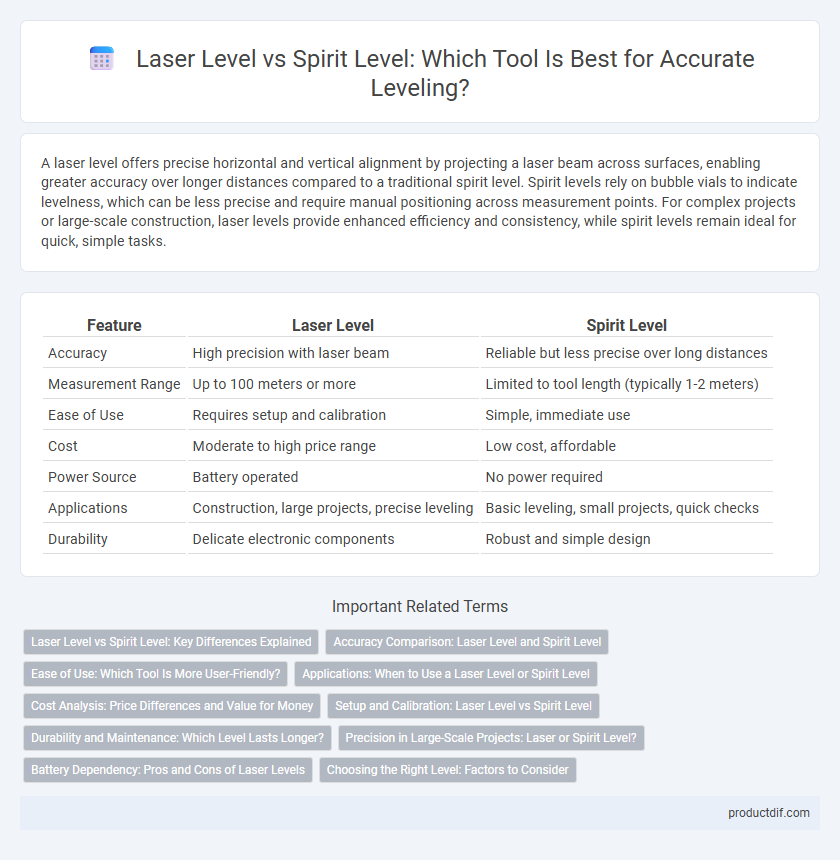A laser level offers precise horizontal and vertical alignment by projecting a laser beam across surfaces, enabling greater accuracy over longer distances compared to a traditional spirit level. Spirit levels rely on bubble vials to indicate levelness, which can be less precise and require manual positioning across measurement points. For complex projects or large-scale construction, laser levels provide enhanced efficiency and consistency, while spirit levels remain ideal for quick, simple tasks.
Table of Comparison
| Feature | Laser Level | Spirit Level |
|---|---|---|
| Accuracy | High precision with laser beam | Reliable but less precise over long distances |
| Measurement Range | Up to 100 meters or more | Limited to tool length (typically 1-2 meters) |
| Ease of Use | Requires setup and calibration | Simple, immediate use |
| Cost | Moderate to high price range | Low cost, affordable |
| Power Source | Battery operated | No power required |
| Applications | Construction, large projects, precise leveling | Basic leveling, small projects, quick checks |
| Durability | Delicate electronic components | Robust and simple design |
Laser Level vs Spirit Level: Key Differences Explained
Laser levels project highly accurate horizontal and vertical reference lines using laser beams, enabling hands-free operation and enhanced precision over long distances. Spirit levels rely on liquid-filled vials with bubbles to indicate levelness, requiring manual alignment and visual judgment. The laser level's advanced technology offers greater versatility for complex construction and surveying tasks compared to the simplicity and affordability of spirit levels.
Accuracy Comparison: Laser Level and Spirit Level
Laser levels provide superior accuracy compared to spirit levels by projecting precise horizontal and vertical lines over long distances, minimizing human error in alignment tasks. Spirit levels rely on bubble vials and require manual positioning, which can introduce slight inconsistencies, especially on uneven surfaces or extended measurements. For projects demanding high precision, laser levels offer reliable, consistent accuracy that outperforms traditional spirit levels.
Ease of Use: Which Tool Is More User-Friendly?
Laser levels provide enhanced ease of use by projecting clear, precise lines over long distances, reducing the need for constant adjustments compared to spirit levels. Spirit levels require manual positioning and frequent checking to ensure accuracy, making them less efficient for larger or complex projects. The intuitive design of laser levels offers increased user-friendliness, especially for beginners and professionals seeking quick, accurate measurements.
Applications: When to Use a Laser Level or Spirit Level
Laser levels excel in large-scale construction projects and outdoor applications where precise horizontal and vertical alignment over long distances is crucial. Spirit levels are ideal for small-scale tasks such as hanging pictures, installing shelves, or carpentry work requiring quick, accurate leveling on short surfaces. Choosing between the two depends on the project size, accuracy requirements, and environmental conditions.
Cost Analysis: Price Differences and Value for Money
Laser levels typically cost between $50 and $300, offering advanced features like self-leveling and greater accuracy, making them ideal for professional use. Spirit levels are more affordable, usually priced from $10 to $50, providing reliable performance for basic leveling tasks but lacking precision and versatility. Evaluating value for money depends on project complexity, with laser levels delivering higher efficiency and precision at a premium price, while spirit levels remain cost-effective for simpler applications.
Setup and Calibration: Laser Level vs Spirit Level
Laser levels require precise initial calibration using built-in electronic sensors and often self-leveling features to ensure accuracy, whereas spirit levels depend on manual adjustment by aligning bubbles within vials. Setting up a laser level involves powering the device, placing it on a stable surface or tripod, and verifying its alignment through laser beams projected on walls or floors. Spirit levels necessitate careful placement and visual checks, with calibration mainly performed by adjusting the zero position or replacing the vial for consistent measurements.
Durability and Maintenance: Which Level Lasts Longer?
Laser levels typically offer higher durability due to solid-state components and rugged housings designed for job site conditions, reducing wear and tear compared to traditional spirit levels. Spirit levels require minimal maintenance and have a simple design with fewer parts prone to damage, but their accuracy can degrade over time if the vial becomes cracked or bubbles develop. In terms of longevity, laser levels generally last longer with proper care and calibration, while spirit levels may need replacement more frequently if subjected to rough handling or environmental stress.
Precision in Large-Scale Projects: Laser or Spirit Level?
Laser levels offer superior precision in large-scale projects by projecting highly accurate horizontal or vertical lines over long distances, minimizing human error common with traditional spirit levels. Spirit levels, while reliable for smaller tasks, lack the advanced calibration and range required to maintain accuracy across extensive surfaces or complex alignments. Project managers prioritize laser levels for tasks demanding consistent precision, such as construction layouts, ensuring efficient workflow and high-quality results.
Battery Dependency: Pros and Cons of Laser Levels
Laser levels require batteries or rechargeable power sources, providing portability and flexibility for use in various job sites without reliance on external power. Battery dependency ensures continuous operation during extended projects but necessitates carrying spare batteries or chargers to prevent downtime. In contrast, spirit levels require no power, offering simplicity and reliability but lack the advanced features found in laser levels.
Choosing the Right Level: Factors to Consider
When choosing between a laser level and a spirit level, consider accuracy requirements, project scale, and ease of use; laser levels provide precise, long-range measurements ideal for large or complex tasks, while spirit levels are cost-effective and reliable for smaller, straightforward jobs. Battery life, calibration frequency, and environmental conditions such as lighting can significantly impact performance. Assessing these factors ensures selection of the most efficient leveling tool tailored to specific construction or DIY needs.
Laser level vs Spirit level Infographic

 productdif.com
productdif.com